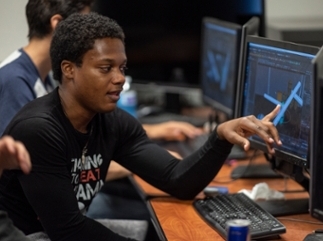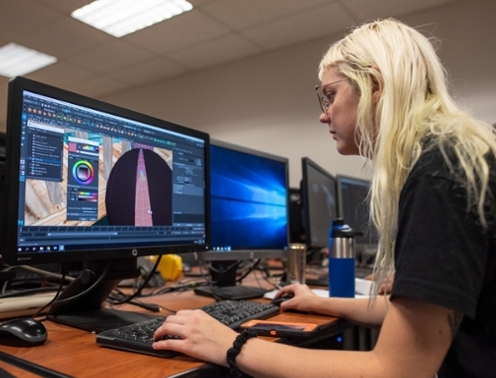
Mission & Objectives
Mission Statement
We prepare students for successful professional careers in the computer animation and game development fields through our innovative program based on the synergy of creativity and technology. Through applied-learning and collaborative environments embracing industry-standard technical and conceptual techniques, we provide the foundation for creative expression and life-long learning that leads our students to be successful and effective contributors, leaders and innovators capable of overcoming complex challenges.
Program Goals & Objectives
- Computer Animation and Game Development graduates will have an understanding of critical and aesthetic issues in computer graphics and mixed-media.
- They will know basic aesthetic principles and concepts, and the production process.
- They will be able to effectively use technical, conceptual and critical abilities, and appropriate technology tools.
- They will be effective written and oral communicators with the ability to function as effective members of collaborative multi-disciplinary teams in the production process.
- They will be able to critically evaluate computer graphics and the mixed media.
- They will have an appreciation for the professional code of ethics for the creative process.
Student Learning Outcomes
- Recognize and evaluate critical and aesthetic issues within computer graphics and the mixed media. (Issues)
- Apply aesthetic judgments and critical thinking skills to art and graphics related issues. (Aesthetics)
- Demonstrate mastery of specific technical, conceptual and critical abilities within computer graphics and the mixed media. (Abilities)
- Demonstrate proficiency with industrial applications to visual communication related technologies. (Proficiency)
- Communicate effectively in written format on research and creative issues. (Written)
- Communicate effectively in oral format on research and creative issues. (Oral)
- Apply critical thinking and aesthetic judgments in critiquing mixed media and computer graphics productions. (Critiquing)
- Function on multi-disciplinary teams. (Teams)
- Work collaboratively and individually with an understanding of the production process utilized in industry-standard studios. (Process)
- Demonstrate professionalism through creative and intellectual independence. (Professionalism)
Curriculum Matrix
Computer Animation and Game Development (CAGD) curriculum is comprised of 120 units in general education, studio art, communication design, computer science, and computer graphics courses. The program learning outcomes are directly assessed in the CAGD core of ten (10) courses constituting thirty (30) units taken by all CAGD majors.
The ten (10) program learning outcomes are distributed throughout the program in multiple courses. The distribution of the program learning outcomes in the required core curriculum can be seen in CAGD Curriculum Matrix Table. The elements in the program learning outcomes are generally introduced in basic courses, then practiced in more advanced courses and then demonstrated in senior-level courses. Assessment of the program learning outcomes occurs throughout the core curriculum. In more advanced courses the assessment measures learning in that particular course as well the overall selected program outcome.


